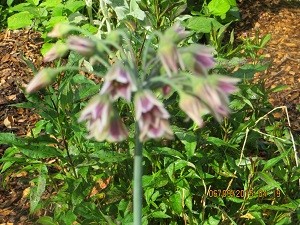There is another “allium” that a number of garden club members have asked about. Their picture is below and I took it in my garden so excuse the poor focus. This plant is Nectaroscordum siculum, formerly known as Allium bulgaricum. Taxonomists have decided that it is not a true allium. It is also found under the taxonomic names Allium siculum, Allium dioscoridis, Nectaroscordum bulgaricum, and Nectaroscordum siculum subsp. bulgaricum. Common names are Mediterranean bells and Sicilian honey lily. The plant is a very near relative of the alliums and has the typical garlic/onion odor. Nectaroscordum means garlic nectar.
The bell shaped flowers hang in clusters in a round globe typical of alliums. There are characteristically 10-30 bells per umbel. The blooms are cream with purple or maroon lines and are more unusual than showy. The blossoms are on a 32-38 inch scape and flowers appear early to mid-June in our area. The seed heads become star shaped as they form. The leaves are approximately 2 feet in length and rather twisted with a central vein.
The blooms are cream with purple or maroon lines and are more unusual than showy. The blossoms are on a 32-38 inch scape and flowers appear early to mid-June in our area. The seed heads become star shaped as they form. The leaves are approximately 2 feet in length and rather twisted with a central vein.
The bulbs are not fussy as to soil but prefer good drainage. Like most bulbs they will not thrive in excessively wet soil. They reportedly do not like crowding and should be divided as they multiply. Mediterranean bells, as their name suggests, are native to woodlands of the countries surrounding the Mediterranean including Turkey, Crimea, Greece, Bulgaria, Romania, Southern France and Italy. They grow in semi-shade but in our cooler summers will take tolerate full sun.
The plants will produce seed and may be grown from seed but typically they are propagated by division. This is done in the fall. They should be planted 4-6 inches deep and 6-8 inches apart. While a number of sources say that Mediterranean bells are marginally hardy in zone 5 and should be mulched heavily, they have survived the -25 to -30 °F temperatures that we have enjoyed the last two winters with little or no protection.
The plants have no diseases or insect problems. They are attractive to bees and I saw a hummingbird sampling them recently. Because of the odor they are not bothered by deer, rabbits or groundhogs. The bulbs are apparently unpalatable to squirrels, voles or mice. Where ever they came from they are an unusual addition to any garden.
Mediterranean bells bloom about the same time as columbine and are pretty when combined with the darker shades. They are also attractive against the silver foliage of lambs ears or artemisia. Because they are so tall, it is possible to grow them with a groundcover such as snow in summer (Cerastium tomentosum) with its silvery foliage and white flowers.
The bulbs are not edible but the leaves are dried and used as seasoning in Bulgaria where it is grown as an herb. The thickest leaves are cut and pulverized with equal parts salt and the mixture is dried. It is used as a seasoning salt on vegetables, potatoes, etc. The leaves may also be used in a similar fashion to chives and the flowers make a pretty garnish. This is a very interesting plant to add to our collection and we thank Ralph for donating it.